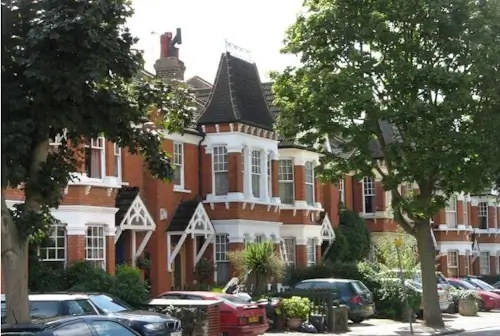The Lakes Estate is an area of mostly Edwardian houses occupying much of the northern side of Aldermans Hill and the streets between there and Fox Lane. In 1902 this area, at the time known as Old Park, formed part of the extensive parkland surrounding Grovelands House, whose owners had strongly resisted housebuilding on their land. However, on the death of the then owner, Old Park was sold by auction to the British Land Company and the process of laying out the current roads was begun. The company sold plots to various housebuilders, who proceeded to build houses "designed to attract residents of a certain social and economic standing".
The vast majority of the houses on the estate were completed between 1905 and 1914 and this short timespan contributed towards the homogeneity and unity of the building, helping make it "the quintessence of middle-class Edwardian suburbia".
The characteristics of the Lakes Estate as built and the fact that it had generally retained its original state made it an obvious candidate for designation as a Conservation Area, and this duly occurred in 2010. The Character Appraisal waxes lyrical about the estate's qualities:
"Stylistically, the estate is characterised by a rich concoction of late Victorian architectural elements - predominantly, but not only, in the picturesque and vernacular revival styles. By 1900, suburban house-builders had adopted the materials and features originated by fashionable architects like Shaw and Devey thirty years before, to give variety, interest and the stamp of good taste to speculative developments. However, these houses are not examples of one architectural revival style or another, but a distinctive suburban type, notable above all for its vigorous and highly eclectic decoration."
In particular, the Character Appraisal praises the woodwork, "above all the glorious variety of entrance porches, with joined, turned, pierced and carved timber detail" and the front doors "with decorative glazing bars and ornate, sometimes flamboyant stained glass". It points out that "front garden walls are a distinctive feature of the estate, originally almost always constructed of irregularly sized brick rubble or ‘wasters’, a by-product of brick-making. The walls usually incorporated red and yellow bricks, with decorative and bonding courses in good bricks. Clinker is sometimes incorporated. The walls are generally topped with half-round blue coping bricks".
What changes might threaten the character of the Lakes Estate?
The purpose of declaring the Lakes Estate a conservation area was to "preserve and enhance" the characteristics described above. Page 47 of the Character Appraisal list some of the changes that have already been made which threaten these characteristics:
- The paving-over of front gardens for car parking
- Loss of traditional boundaries and front garden planting
- Inappropriate replacement of traditional high quality joinery, particularly windows and porches
- The painting of original fair-faced brickwork and unpainted render
- Inappropriate alterations to roofs
- Loss of original high quality shop-fronts and installation of solid external security shutters
- The degraded environment of the mews streets
- Loss of some street trees.
- Installation of photo-voltaic roof panels.
It is to prevent further inappropriate changes being made to properties that the "permitted rights" have been withdrawn.
It is the wish of Enfield Council and of the Friends of the Lakes Estate Conservation Area that wherever possible, these undesirable changes should be reversed. Indeed, many property owners have already been willing to replace non-traditional windows, walls and roofing, and to strip paint from brickwork, so restoring the glory of the Estate identified by the Character Study.




